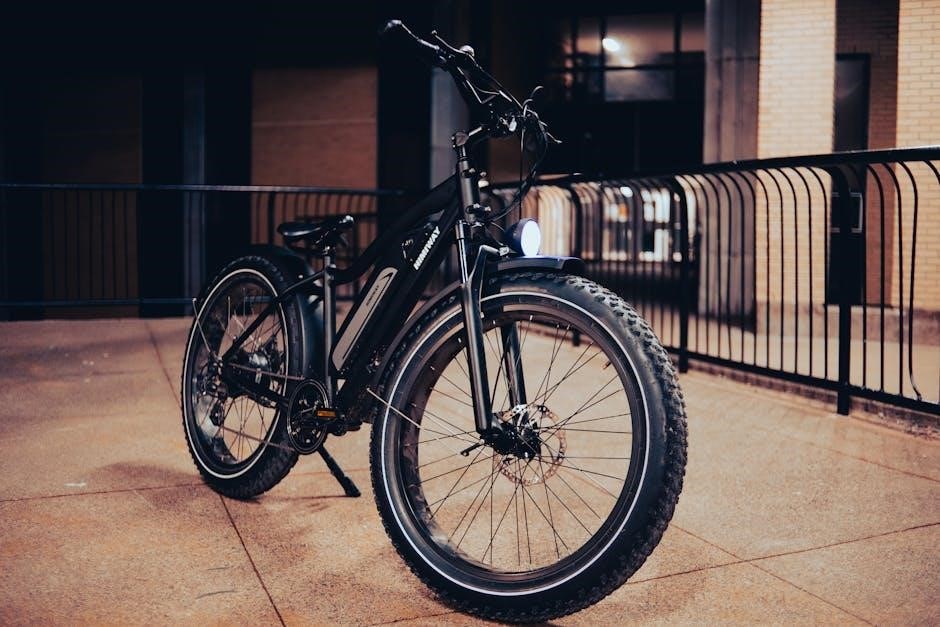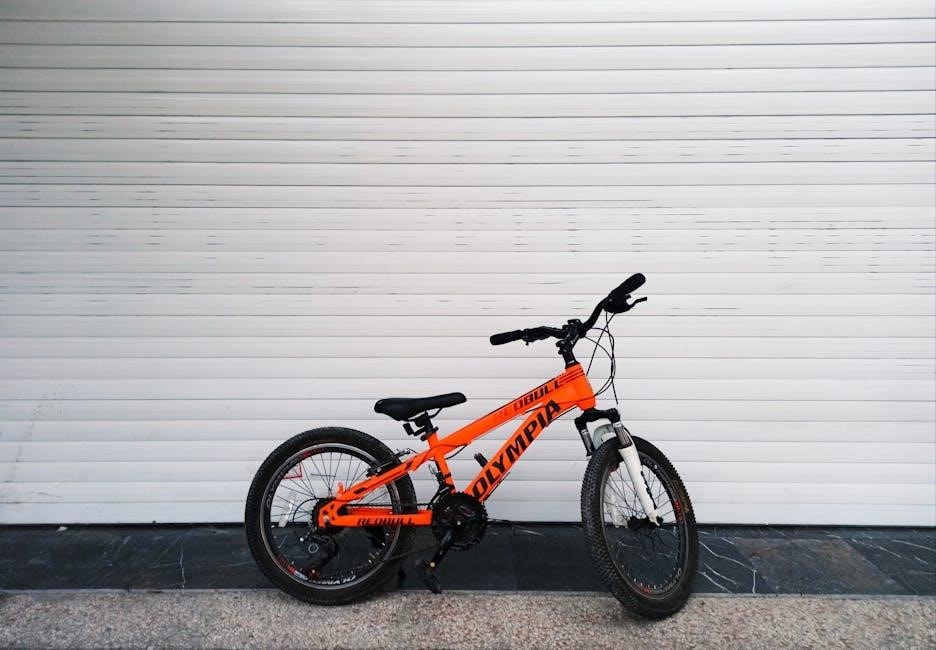Bike frame sizes are essential for ensuring proper fit, comfort, and efficiency. Measuring height, inseam, and reach accurately helps determine the ideal frame size, optimizing performance and reducing injury risks. Sizing varies across bike types, with road, mountain, and hybrid bikes requiring specific measurements. Using sizing charts or online calculators can simplify the process, ensuring the perfect match for your riding style and body proportions. Proper sizing enhances overall cycling experience, making it crucial for both casual and professional riders.
Why Bike Frame Size Matters
A properly sized bike frame is crucial for rider comfort, efficiency, and safety. A bike that is too small or too large can lead to discomfort, inefficiency, and even potential injuries. When the frame size matches the rider’s body proportions, it ensures optimal performance and reduces the risk of strain or discomfort during long rides. Proper sizing also improves control and maneuverability, which are critical for navigating various terrains. Additionally, a well-fitted bike enhances pedaling efficiency, allowing riders to conserve energy and maintain a consistent pace. Ultimately, the right frame size ensures a more enjoyable and safe cycling experience, making it essential to prioritize accurate measurements and sizing when selecting a bike.
Understanding Bike Frame Size Measurements
Bike frame sizes are typically measured in inches, reflecting the distance from the center of the bottom bracket to the top of the seat tube. This measurement varies slightly between manufacturers, as some may include standover height or top tube length. Standover height, the space between the ground and the top tube, is crucial for safety and comfort. Proper frame size ensures optimal riding posture, efficient pedaling, and better control. Different bike types, like road, mountain, or hybrid, have specific sizing standards. Using a bike size chart or calculator can help determine the ideal frame size based on height and inseam, ensuring a perfect fit for various riding styles and terrains.
Inches vs. Other Sizing Methods
Bike frame sizes are often measured in inches, reflecting the seat tube length, but other methods like centimeters or generic sizes (S, M, L, etc.) are also used. While inches provide a precise measurement, variations exist between brands due to differences in frame geometry. Some manufacturers use a combination of height and inseam to determine size, offering a more personalized fit. Online calculators and sizing charts are increasingly popular for their accuracy. Standover height and reach are also considered, especially for mountain bikes, where clearance and handling are critical. Ultimately, inches remain a standard, but other methods, like test rides, are crucial for confirming the perfect fit, ensuring comfort and performance across different bike types.

How to Measure Yourself for a Bike
Accurately measuring yourself for a bike involves assessing your height, inseam, reach, and standover clearance. Start by measuring your height in inches while standing barefoot. Next, measure your inseam by placing a book between your legs and marking the floor level. This helps determine the appropriate standover height; Use a bike size chart or online calculator to translate these measurements into a recommended frame size. Consider your riding style and bike type, as road, mountain, and hybrid bikes have different sizing standards. Professional fittings are beneficial for optimal comfort and performance, ensuring the perfect bike-to-rider fit.
Measuring Your Height Accurately
Accurately measuring your height is the first step in determining the right bike frame size. Stand barefoot on a flat surface with your feet shoulder-width apart. Place a measuring tape or ruler against a wall and mark the top of your head. Measure from the floor to this mark to get your height in inches. Ensure the tape is straight and level for precise results. Consistency is key, so maintain the same posture each time you measure. This measurement is crucial for comparing against bike size charts, as it forms the basis for selecting the correct frame size. Proper height measurement ensures a comfortable and efficient riding experience. Always double-check your measurements for accuracy to avoid sizing errors. This step is foundational for a well-fitting bike.
Understanding Inseam and Its Importance
Inseam is a critical measurement for determining bike frame size. It refers to the distance from the floor to the top of your inner thigh, which is essential for ensuring proper standover clearance. To measure inseam accurately, stand against a wall with your feet shoulder-width apart. Place a hardcover book between your legs, flush against the wall, and measure the distance from the floor to the top of the book using a ruler. This measurement helps calculate the ideal standover height, ensuring your bike is neither too large nor too small. Proper inseam measurement is vital for comfort, safety, and efficiency, as it directly impacts your ability to dismount and maneuver the bike confidently. Ignoring inseam can lead to discomfort or inefficiency, making it a key factor in achieving the perfect fit. By combining inseam with height, riders can select a frame size that optimizes their cycling experience.
Measuring Your Reach and Aperture
Reach refers to the distance from your saddle to the handlebars, influencing how stretched or comfortable you feel while riding. To measure reach, stand upright with your arms at your sides, then extend them forward to grip the handlebars. A bike with the correct reach ensures your arms are slightly bent, allowing control and comfort. Aperture, or standover clearance, is the space between your crotch and the bike’s top tube when standing over the frame. Measure this by standing with the bike between your legs, ensuring at least 1-2 inches of clearance for road bikes and 2-4 inches for mountain bikes. Proper reach and aperture ensure optimal fit, preventing discomfort and improving performance. These measurements are vital for maintaining control and reducing injury risks, making them essential for a safe and enjoyable cycling experience.

Types of Bikes and Their Sizing
Different bike types—road, mountain, hybrid, and kids’ bikes—use various sizing methods. Road bikes often use frame sizes in inches, while mountain bikes may use inches or other systems. Hybrid and city bikes combine elements, with sizing based on height and riding style. Kids’ bikes are typically sized by wheel size or age. Proper sizing ensures optimal fit, comfort, and performance, making it crucial to consult specific charts for each bike type to match your needs.
Road Bike Frame Sizes
Road bike frame sizes are typically measured in inches and cater to specific rider heights. Frames range from 47cm to 63cm, with taller riders opting for larger sizes. Proper sizing ensures optimal reach, comfort, and aerodynamic positioning. Standover height is crucial for safety and comfort, allowing a small gap between the rider and the frame. Sizing charts often align height with frame size, but individual proportions and riding style can influence the final choice. Consulting a detailed sizing chart or a professional fitter is recommended for the best fit, ensuring efficiency, comfort, and peak performance during rides.

Mountain Bike Frame Sizes
Mountain bike frame sizes are designed to accommodate various rider heights and terrain demands. Frames typically range from 13 to 23 inches, with sizes increasing in small increments. Rider height and inseam are key measurements, ensuring proper standover clearance and maneuverability. A general rule is 2-4 inches of clearance for optimal comfort and control. Mountain bikes often feature sloping top tubes, affecting standover height, and sizing charts vary by manufacturer. Choosing the right size enhances stability, handling, and performance on trails, making it essential to consult specific charts or seek professional advice for the perfect fit and riding experience.
Hybrid and City Bike Frame Sizes
Hybrid and city bikes offer versatility for commuting and casual rides, with frame sizes catering to comfort and practicality. Frames typically range from 16 to 22 inches, designed for upright riding positions. Standover height is crucial, ensuring 1-2 inches of clearance for comfort and ease of use. Sizing charts vary by manufacturer, so consulting specific guides is recommended. Hybrid bikes often feature relaxed geometries, while city bikes prioritize durability and utility. Proper fit ensures efficient pedaling and handling, making them ideal for urban environments. Test rides are encouraged to confirm the best size, as personal comfort and riding style play significant roles in selection.
Kids Bike Frame Sizes
Kids’ bike frame sizes are designed to accommodate growth and varying skill levels. Frames typically range from 12 to 26 inches, with sizes often categorized by wheel size and age suitability. Balance bikes for toddlers start at 12 inches, while pedal bikes for older children range from 16 to 26 inches. Height and inseam measurements are critical for proper fit, ensuring safety and ease of handling. Parents should consider adjustable components to extend the bike’s usability as the child grows. Sizing charts vary by brand, so it’s essential to consult specific guides or visit a local bike shop for expert advice to ensure the perfect fit for developing riders.
Factors Influencing Bike Frame Size
Bike frame size is influenced by height, inseam, reach, and body proportions. Riding style, terrain, and flexibility also play a role in determining the ideal fit for comfort and performance.
Body Proportions and Flexibility
Body proportions, such as torso length, arm reach, and leg proportions, significantly influence bike frame size. Riders with longer torsos may need a larger frame for comfort, while shorter torsos may prefer a smaller size. Flexibility also plays a role, as less flexible riders might require a more upright riding position. Leg proportions, including inseam length, are crucial for standover height and proper pedal stroke. Combining these factors with height ensures a personalized fit. Using a bike sizing chart or consulting a professional can help tailor the frame size to individual body types, optimizing comfort and efficiency for the best cycling experience.
Riding Style and Terrain
Riding style and terrain significantly impact bike frame size selection. Road bikes, designed for speed, require a frame size that supports an aerodynamic position, optimizing efficiency on paved surfaces. Mountain bikes, built for rough trails, need a frame size that ensures stability and control over uneven terrains. For hills and inclines, a slightly smaller frame may offer better maneuverability, while flat terrains might favor a larger frame for speed. Casual riders may prefer a more upright position for comfort, whereas competitive racers might prioritize a more aggressive fit. Understanding how riding style and terrain interact helps tailor frame size to specific needs, enhancing both performance and comfort.
Adjustable Components and Their Impact
Adjustable components play a crucial role in fine-tuning bike fit. Seatposts, stems, and handlebars can be adjusted to accommodate rider proportions, offering flexibility beyond frame size. A longer stem may improve reach for taller riders, while a shorter stem suits those with a more compact frame. Seat height adjustments ensure proper leg extension, preventing strain and optimizing pedaling efficiency; Handlebar height and angle can be tailored to riding style, whether for comfort or performance. These adjustments complement frame size, allowing riders to achieve a personalized fit. However, they shouldn’t compensate for a poorly chosen frame size. Balancing adjustable components with the right frame size ensures optimal comfort, efficiency, and control, making every ride enjoyable and performance-driven.

How to Use a Bike Sizing Chart
Use a bike sizing chart by measuring your height and inseam, then matching these to the chart’s frame size recommendations for your bike type.
Interpreting Bike Size Charts
Bike size charts are tools that match your height and inseam to the appropriate frame size for your preferred bike type. To interpret them, start by accurately measuring your height and inseam. Next, locate the corresponding measurements on the chart, which typically list frame sizes in inches or standard categories (e.g., XS, S, M). Different bike types, such as road, mountain, or hybrid, may have varying sizing standards, so ensure you’re using the correct chart for your bike style. Some charts also provide recommended standover heights for safety and comfort. Online calculators can further refine your size by considering additional factors like reach and riding style. Always cross-reference with manufacturer guidelines for precise fit.
Using Online Bike Size Calculators

Online bike size calculators simplify the process of finding your ideal frame size by analyzing your height, inseam, and sometimes reach or arm span. These tools provide personalized recommendations based on your inputs, catering to different bike types like road, mountain, or hybrid. They often include visual aids, such as charts or graphs, to help you understand your results better. To use them effectively, ensure your measurements are accurate and select the correct bike category. While they save time and reduce guesswork, always cross-reference the results with manufacturer sizing charts for precision. This approach ensures a tailored fit, enhancing comfort and performance for your cycling needs.
Understanding Standover Height
Standover height is a critical measurement in determining bike fit, representing the clearance between the rider and the bike frame when standing over it. It ensures safety and comfort by providing sufficient space to avoid hitting the frame while dismounting or maneuvering. Typically measured in inches, standover height varies by bike type, with road bikes requiring about 1-2 inches of clearance and mountain bikes needing slightly more due to rough terrain demands. Proper standover height prevents discomfort and reduces injury risks, contributing to a safer and more enjoyable cycling experience. Always consider this measurement alongside other factors like reach and inseam for optimal bike sizing.

Importance of Proper Bike Fit
Proper bike fit is crucial for comfort, efficiency, and safety. A well-fitting bike reduces discomfort, improves performance, and minimizes injury risks, ensuring an enjoyable riding experience.
Comfort and Efficiency
A properly fitting bike ensures optimal comfort and efficiency, allowing riders to maintain their position without strain. When the frame size matches the rider’s height and inseam, it supports the body’s natural alignment, reducing pressure on the back, neck, and arms. This alignment also enhances pedaling efficiency, as energy is transferred more effectively to the pedals. A bike that fits well minimizes fatigue, enabling longer rides and better performance. Comfort and efficiency are closely linked, as a well-fitting bike reduces discomfort and allows riders to focus on their cycling experience. Proper fit is key to enjoying every ride, whether for leisure or competitive purposes.

Preventing Injuries
A properly sized bike frame is crucial for preventing injuries. A bike that is too small or too large can lead to poor posture, strained muscles, and discomfort, increasing the risk of injury. Incorrect frame size can cause issues such as back pain, neck strain, or joint discomfort during rides. A well-fitting bike ensures optimal body alignment, reducing pressure on sensitive areas and minimizing the risk of long-term damage. Additionally, proper fit improves control and stability, reducing the likelihood of accidents caused by an ill-fitting bike. Prioritizing the right frame size is essential for safeguarding your health and enjoying a safe, injury-free cycling experience.
Optimizing Performance
A correctly sized bike frame is essential for optimizing performance. A frame that matches your body proportions enables efficient energy transfer, improving pedaling power and speed. Proper fit ensures optimal aerodynamics, reducing air resistance and enhancing overall efficiency. A well-sized bike allows for better weight distribution, maximizing control and maneuverability, especially on challenging terrain. Additionally, the right frame size minimizes unnecessary strain, reducing fatigue and allowing riders to maintain peak performance over longer distances. By ensuring the frame aligns with your height, inseam, and riding style, you can unlock your full potential, achieving faster speeds and better handling. A perfect fit is key to maximizing your cycling performance and enjoying a more rewarding ride.

Advanced Considerations
Advanced bike sizing involves understanding frame geometry, such as stack, reach, and wheelbase. These measurements fine-tune handling and comfort, ensuring optimal performance for specific riding styles. Custom frames and precision fitting techniques like 3D scanning further enhance accuracy, while adjustable components allow for tailored ergonomics. Emerging trends, such as dynamic fitting, consider rider flexibility and movement, offering a more personalized approach to bike sizing. These advanced methods ensure a bike that not only fits but also maximizes efficiency, comfort, and control for serious cyclists seeking peak performance.
Bike Geometry and Its Effects
Bike geometry refers to the measurements and angles of a bike frame, such as stack, reach, wheelbase, and head tube angle. These dimensions significantly impact handling, stability, and rider comfort. A longer wheelbase improves stability but may reduce agility, while a steeper head tube angle enhances maneuverability for road bikes. For mountain bikes, a slacker head tube angle increases downhill control. Understanding geometry helps riders choose bikes suited to their riding style, whether prioritizing speed, comfort, or off-road performance. Adjusting components like stems and handlebars can further fine-tune the fit. Proper geometry alignment ensures optimal power transfer, efficiency, and long-ride comfort, making it a critical factor in bike frame selection.
Custom and Bespoke Frames
Custom and bespoke bike frames are tailored to individual riders’ measurements, riding style, and preferences. These frames offer optimal fit and performance, addressing specific needs such as body proportions, flexibility, and terrain demands. Unlike standard frames, custom options allow for precise adjustments in geometry, ensuring maximum comfort and efficiency. Bespoke frames often use high-quality materials and craftsmanship, providing durability and a personalized aesthetic. While more expensive, they deliver unparalleled fit and performance, making them a worthwhile investment for serious cyclists seeking a unique, high-end riding experience tailored to their exact specifications and riding goals.
Upgrading or Adjusting Your Bike
Upgrading or adjusting your bike can significantly enhance comfort and performance. Components like stems, handlebars, and saddles can be tailored to fit your body proportions and riding style. Adjusting the saddle height and angle ensures proper leg extension and reduces discomfort. Upgrading to ergonomic handlebars or a longer stem can improve reach and posture. For riders seeking a perfect fit, professional bike fitting services are available, offering precise adjustments based on biomechanics. Additionally, considering custom or bespoke frames can provide a tailored solution for unique needs. Regular adjustments and upgrades ensure your bike evolves with your riding style and preferences, optimizing your overall cycling experience and satisfaction.
Selecting the right bike frame size ensures comfort, efficiency, and optimal performance. Proper fit enhances cycling enjoyment, reduces injury risks, and maximizes your riding experience, making it a worthwhile investment.
Final Tips for Choosing the Right Size
When selecting your bike size, start by consulting a reliable sizing chart for your specific bike type. Measure your height and inseam accurately, and consider your riding style and terrain. Test rides are crucial to ensure comfort and fit. If possible, visit a local bike shop for professional guidance. Adjustable components like stems and seatposts can fine-tune your fit, so consider these when making your choice. Prioritize comfort and efficiency to enjoy your cycling experience fully. Remember, the right size enhances performance, reduces injury risks, and ensures long-term satisfaction with your bike. Always double-check your measurements and consider customization options if needed.
Importance of Test Rides
A test ride is the ultimate way to confirm your bike size and fit. It allows you to assess comfort, handling, and overall feel in real-world conditions. Even with precise measurements, a test ride ensures the bike suits your riding style and terrain. Pay attention to standover height, saddle comfort, and reach to the handlebars. A proper test ride should include various terrains to evaluate performance and ergonomics. Wear appropriate cycling gear for an accurate assessment. If purchasing online, consider in-store test rides or rental options. This step is crucial for long-term satisfaction, as it validates your size choice and ensures a enjoyable cycling experience tailored to your needs and preferences.
Long-Term Satisfaction with Your Bike
A well-fitting bike is key to long-term satisfaction, ensuring comfort and performance over time. Proper frame size and adjustments prevent discomfort and injuries, making rides enjoyable for years. A bike that matches your body proportions and riding style enhances efficiency and control, reducing fatigue on long rides. Regular maintenance and ergonomic adjustments also play a role in sustaining comfort. Consulting sizing charts and professional advice helps tailor your bike to your needs, fostering a lasting connection with your cycling experience. Ultimately, a bike that fits perfectly becomes a trusted companion, offering countless miles of joy and adventure.

Additional Resources
Explore bike sizing tools, guides, and calculators online for precise measurements. Visit manufacturer websites, cycling forums, and specialized bike-fitting platforms for comprehensive support and detailed charts.
Recommended Bike Sizing Tools
Utilize online bike size calculators and manufacturer-specific sizing charts for precise measurements. Tools like BikeSizeCalculator.com and specialized apps provide detailed fit recommendations. Visit websites such as JustChartIt for frame size guides. Many cycling platforms offer interactive tools to input height, inseam, and reach for accurate frame size suggestions. Additionally, local bike shops often provide professional fitting services using advanced equipment. Standover height calculators are also available to ensure proper clearance. These resources help cyclists of all levels find their ideal bike size, ensuring comfort, efficiency, and safety while riding. Always consult multiple tools for consistency and accuracy in your frame size selection.
Further Reading and Guides
Explore comprehensive guides and resources to deepen your understanding of bike sizing. Websites like JustChartIt and BikeSizeCalculator.com offer detailed charts and calculators. Check out tutorials on YouTube for visual explanations of frame measurement techniques. Professional cycling blogs often share insights on optimizing fit for specific riding styles. Additionally, manufacturer websites provide model-specific sizing information, ensuring accuracy for your preferred bike type. For advanced customization, explore forums discussing bespoke frames and upgrades. These resources empower cyclists to make informed decisions, ensuring long-term satisfaction and optimal performance on the road or trail.
Consulting with a Professional
Consulting with a professional at a local bike shop can provide personalized guidance for finding the perfect frame size. Experts use precise measurements and sizing charts to recommend the ideal fit. They consider factors like riding style, body proportions, and flexibility to ensure comfort and efficiency. Professional fitters can also adjust components like stems and saddles for optimal performance. Visiting a professional ensures a tailored fit, reducing the risk of discomfort or injury. Many shops offer free or low-cost sizing sessions, making it a valuable investment for long-term satisfaction. Their expertise complements online tools, providing a comprehensive approach to choosing the right bike frame size.



Leave a Reply
You must be logged in to post a comment.